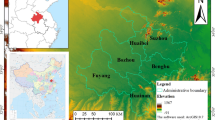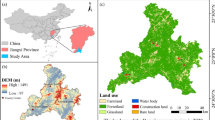Abstract
Environmental sustainability is the foundation and of great significance for the sustainable development of urban agglomerations. Taking the Beijing-Tianjin-Hebei urban agglomeration as an example, we developed a method to effectively assess long-term regional environmental sustainability based on the Google Earth Engine (GEE) platform. We used the GEE to obtain 5206 Landsat remote sensing images in the region from 1983 to 2016 and developed the comprehensive environmental index (CEI) to assess regional environmental sustainability based on the theme-oriented framework proposed by the United Nations Commission on Sustainable Development. We found that the environmental sustainability of the urban agglomeration showed a trend of first rising, then falling, and then rising again in the past 30 years. The average CEI increased from 0.621 to 0.631 from 1985 to 1990, dropped to the lowest value of 0.618 in 2000, and then rose to the highest value of 0.672 in 2015. In particular, the extent of areas in which environmental sustainability improved (56% of the region) was greater than the extent of areas in which environmental deterioration occurred. The environmental sustainability of Hengshui, Xingtai, and Cangzhou in the southeast of the region has been significantly improved. The method proposed in this study provides an automatic, rapid, and extensible way to assess regional environmental sustainability and provides a scientific reference for improving the sustainability of the regional environment.












Similar content being viewed by others
Data Availability
The datasets generated and/or analyzed during the current study are not publicly available due to the sensitive nature of the raw data but are available from the corresponding author on reasonable request.
References
Baig MHA, Zhang L, Shuai T, Tong Q (2014) Derivation of a tasselled cap transformation based on Landsat 8 at-satellite reflectance. Remote Sens Lett 5(5):423–431
Brent AC, Heuberger R, Manzini D (2005) Evaluating projects that are potentially eligible for Clean Development Mechanism (CDM) funding in the South African context: a case study to establish weighting values for sustainable development criteria. Environ Dev Econ 10(5):631–649
Brundtland GH (1987) Our common future—call for action. Environ Conserv 14(4):291–294
Bryan BA, Gao L, Ye Y, Sun X, Connor JD, Crossman ND, Hou X (2018) China’s response to a national land-system sustainability emergency. Nature 559(7713):193–204
Caselles V, Valor E, Coll C, Rubio E (1997) Thermal band selection for the PRISM instrument: 1. Analysis of emissivity‐temperature separation algorithms. Journal of Geophysical Research: Atmospheres 102(D10):11145–11164
Chen W, Huang H, Tian Y, Du Y (2019a) Monitoring and assessment of the eco-environment quality in the Sanjiangyuan region based on Google Earth Engine. J Geo-Inform Sci 21(09):1382–1391 ((in Chinese))
Chen S, Huang Q, Liu Z, Meng S, Yin D, Zhu L, He C (2019b) Assessing the regional sustainability of the Beijing-Tianjin-Hebei Urban Agglomeration from 2000 to 2015 using the human sustainable development index. Sustainability 11(11):3160
Cheng L, Wang Z, Tian S, Liu Y, Sun M, Yang Y (2021) Evaluation of eco-environmental quality in Mentougou District of Beijing based on improved remote sensing ecological index. Chin J Ecol 40(04):1177–1185 ((in Chinese))
Coops NC, Wulder MA, Duro DC, Han T, Berry S (2008) The development of a Canadian dynamic habitat index using multi-temporal satellite estimates of canopy light absorbance. Ecol Ind 8(5):754–766
Crist EP (1985) A TM tasseled cap equivalent transformation for reflectance factor data. Remote Sens Environ 17(3):301–306
Duguay-Tetzlaff A, Bento VA, Göttsche FM, Stöckli R, Martins J, Trigo I, Kunz H (2015) Meteosat land surface temperature climate data record: achievable accuracy and potential uncertainties. Remote Sens 7(10):13139–13156
Ermida SL, Soares P, Mantas V, Göttsche FM, Trigo IF (2020) Google earth engine open-source code for land surface temperature estimation from the landsat series. Remote Sens 12(9):1471
Estoque RC (2020) A review of the sustainability concept and the state of SDG monitoring using remote sensing. Remote Sens 12(11):1770
Fairbanks DH, McGwire KC (2004) Patterns of floristic richness in vegetation communities of California: regional scale analysis with multi-temporal NDVI. Glob Ecol Biogeogr 13(3):221–235
Gandhi GM, Parthiban S, Thummalu N, Christy A (2015) Ndvi: Vegetation change detection using remote sensing and gis–a case study of Vellore District. Proc Comput Sci 57:1199–1210
Goodland R (1995) The concept of environmental sustainability. Annu Rev Ecol Syst 26(1):1–24
Goodland R, Daly H (1996) Environmental sustainability: universal and non-negotiable. Ecol Appl 6(4):1002–1017
Goward SN, Xue Y, Czajkowski KP (2002) Evaluating land surface moisture conditions from the remotely sensed temperature/vegetation index measurements: an exploration with the simplified simple biosphere model. Remote Sens Environ 79(2–3):225–242
Hansen MC, Potapov PV, Moore R, Hancher M, Turubanova SA, Tyukavina A, Townshend J, et al (2013) High-resolution global maps of 21st-century forest cover change. Science 342(6160):850–853
He C, Gao B, Huang Q, Ma Q, Dou Y (2017) Environmental degradation in the urban areas of China: evidence from multi-source remote sensing data. Remote Sens Environ 193:65–75
Hu X, Xu H (2018) A new remote sensing index for assessing the spatial heterogeneity in urban ecological quality: a case from Fuzhou City, China. Ecol Ind 89:11–21
Kalnay E, Kanamitsu M, Kistler R, Collins W, Deaven D, Gandin L, Joseph D (1996) The NCEP/NCAR 40-year reanalysis project. Bull Am Meteor Soc 77(3):437–472
Kumar L, Mutanga O (2018) Google Earth Engine applications since inception: usage, trends, and potential. Remote Sensing 10(10):1509
Li C, Fu B, Wang S, Stringer LC, Wang Y, Li Z, Zhou W (2021) Drivers and impacts of changes in China’s drylands. Nat Rev Earth Environ 2(12):858–873
Liu D, Hao S (2017) Ecosystem health assessment at county-scale using the pressure-state-response framework on the Loess Plateau, China. Int J Environ Res Public Health 14(1):2
Lu L, Weng Q, Guo H, Feng S, Li Q (2019) Assessment of urban environmental change using multi-source remote sensing time series (2000–2016): a comparative analysis in selected megacities in Eurasia. Sci Total Environ 684:567–577
Lu L, Xu Y, Huang A, Liu C, Marcos-Martinez R, Huang L (2020) Influences of topographic factors on outcomes of forest programs and policies in a mountain region of China: a case study. Mt Res Dev 40(1):R48
Ministry of Ecology and Environment of the People’s Republic of China. (2015). Technical criterion for ecosystem status evaluation (HJ 192–2015)
Midekisa A, Holl F, Savory DJ, Andrade-Pacheco R, Gething PW, Bennett A, Sturrock HJ (2017) Mapping land cover change over continental Africa using Landsat and Google Earth Engine cloud computing. PloS One 12(9):e0184926
Olafsson S, Cook D, Davidsdottir B, Johannsdottir L (2014) Measuring countries׳ environmental sustainability performance–a review and case study of Iceland. Renew Sustain Energy Rev 39:934–948
Rikimaru A, Roy PS, Miyatake S (2002) Tropical forest cover density mapping. Trop Ecol 43(1):39–47
Rubio E, Caselles V, Badenas C (1997) Emissivity measurements of several soils and vegetation types in the 8–14, μm Wave band: analysis of two field methods. Remote Sens Environ 59(3):490–521
Sands GR, Podmore TH (2000) A generalized environmental sustainability index for agricultural systems. Agr Ecosyst Environ 79(1):29–41
Schmidt-Traub G, Kroll C, Teksoz K, Durand-Delacre D, Sachs JD (2017) National baselines for the Sustainable Development Goals assessed in the SDG Index and Dashboards. Nat Geosci 10(8):547–555
Senay GB, Elliott RL (2000) Combining AVHRR-NDVI and landuse data to describe temporal and spatial dynamics of vegetation. For Ecol Manage 128(1–2):83–91
Shan W, Jin X, Meng X, Yang X, Xu Z, Gu Z, Zhou Y (2019) Dynamical monitoring of ecological environment quality of land consolidation based on multi-source remote sensing data. Trans Chin Soc Agric Eng 35(01):234–242 ((in Chinese))
Shruti S, Singh PK, Ohri A (2021) Evaluating the environmental sustainability of smart cities in India: the design and application of the Indian smart city environmental sustainability index. Sustainability 13(1):327
Singh A, Jakubowski AR, Chidister I, Townsend PA (2013) A MODIS approach to predicting stream water quality in Wisconsin. Remote Sens Environ 128:74–86
Sutton PC (2003) An empirical environmental sustainability index derived solely from nighttime satellite imagery and ecosystem service valuation. Popul Environ 24(4):293–311
Tan J, Zheng Y, Tang X, Guo C, Li L, Song G, Chen H (2010) The urban heat island and its impact on heat waves and human health in Shanghai. Int J Biometeorol 54(1):75–84
UN (2007) Indicators of sustainable development: guidelines and methodologies. thirded. United Nations, New York
Ustin SL (ed) (2004) Manual of remote sensing, remote sensing for natural resource management and environmental monitoring (vol. 4). John Wiley & Sons
Wan H, Huo F, Niu Y, Zhang W, Zhang Q (2021) Dynamic monitoring and analysis of ecological environment change in Cangzhou city based on RSEI model considering PM2.5 concentration. Prog Geophys 36(03):953–960 (in Chinese)
Wang Q (2021) Progress of environmental remote sensing monitoring technology in China and some related frontier issues. Natl Remote Sens Bull 25(01):25–36 ((in Chinese))
Wang Q, Wang L, Wei C, Jin Y, Li Z, Tong X, Atkinson PM (2021) Filling gaps in Landsat ETM+ SLC-off images with Sentinel-2 MSI images. Int J Appl Earth Observ Geoinform 101:102365
Wang Z, Liang L, Sun Z, Wang X (2019) Spatiotemporal differentiation and the factors influencing urbanization and ecological environment synergistic effects within the Beijing-Tianjin-Hebei urban agglomeration. J Environ Manage 243:227–239
Wu J (2013) Landscape sustainability science: ecosystem services and human well-being in changing landscapes. Landscape Ecol 28(6):999–1023
Wu J, Wu T (2012) Sustainability indicators and indices: an overview. Handb Sustain Manage 65–86
Xu H (2005) A study on information extraction of water body with the modified normalized difference water index (MNDWI). J Remote Sens 5:589–595
Xu H (2008) A new index for delineating built-up land features in satellite imagery. Int J Remote Sens 29(14):4269–4276
Xu H (2013a) A remote sensing urban ecological index and its application. Acta Ecol Sin 33(24):7853–7862 ((in Chinese))
Xu H (2013b) A remote sensing index for assessment of regional ecological changes. China Environ Sci 33(5):889–897
Xu H (2013c) Assessment of ecological change in soil loss area using remote sensing technology. Trans Chin Soc Agric Eng 29(7):91–97
Xu H, Wang Y, Guan H, Shi T, Hu X (2019) Detecting ecological changes with a remote sensing based ecological index (RSEI) produced time series and change vector analysis. Remote Sens 11(20):2345
Xu K, Chi Y, Wang J, Ge R, Wang X (2021) Analysis of the spatial characteristics and driving forces determining ecosystem quality of the Beijing–Tianjin–Hebei region. Environ Sci Pollut Res 28(10):12555–12565
Xu Z, Chau SN, Chen X, Zhang J, Li Y, Dietz T, Liu J (2020) Assessing progress towards sustainable development over space and time. Nature 577(7788):74–78
Yeerkenbieke G, Chen C, He G (2021) Public perceived effects of 2022 Winter Olympics on host city sustainability. Sustainability 13(7):3787
Zhang L, Huang Q, He C, Yue H, Zhao Q (2021) Assessing the dynamics of sustainability for social-ecological systems based on the adaptive cycle framework: a case study in the Beijing-Tianjin-Hebei urban agglomeration. Sustain Cities Soc 70:102899
Acknowledgements
We express our gratitude to the anonymous reviewers and editors for their insightful and critical comments, which have improved the quality of the manuscript.
Funding
This research was supported in part by the National Natural Science Foundation of China (Grant No. 41971225), the Beijing Municipal Natural Science Fund (Grant No. 8192027), and the Beijing Normal University Tang Scholar.
Author information
Authors and Affiliations
Contributions
Xianwang Xia: data processing and analysis, writing—original draft preparation, and visualization.
Chentai Jiao: data processing and analysis.
Shixiong Song: data processing and analysis, conceptualization, and methodology.
Ling Zhang: writing—review and editing, and methodology.
Xingyun Feng: writing—review and editing.
Qingxu Huang: conceptualization, supervision, and writing—review and editing.
Corresponding author
Ethics declarations
Ethics approval
Not applicable.
Consent to participate
Not applicable.
Consent for publication
Not applicable.
Competing interests
The authors declare no competing interests.
Additional information
Communicated by Philippe Garrigues.
Publisher's Note
Springer Nature remains neutral with regard to jurisdictional claims in published maps and institutional affiliations.
Rights and permissions
About this article
Cite this article
Xia, X., Jiao, C., Song, S. et al. Developing a method for assessing environmental sustainability based on the Google Earth Engine platform. Environ Sci Pollut Res 29, 57437–57452 (2022). https://doi.org/10.1007/s11356-022-19773-z
Received:
Accepted:
Published:
Issue Date:
DOI: https://doi.org/10.1007/s11356-022-19773-z




